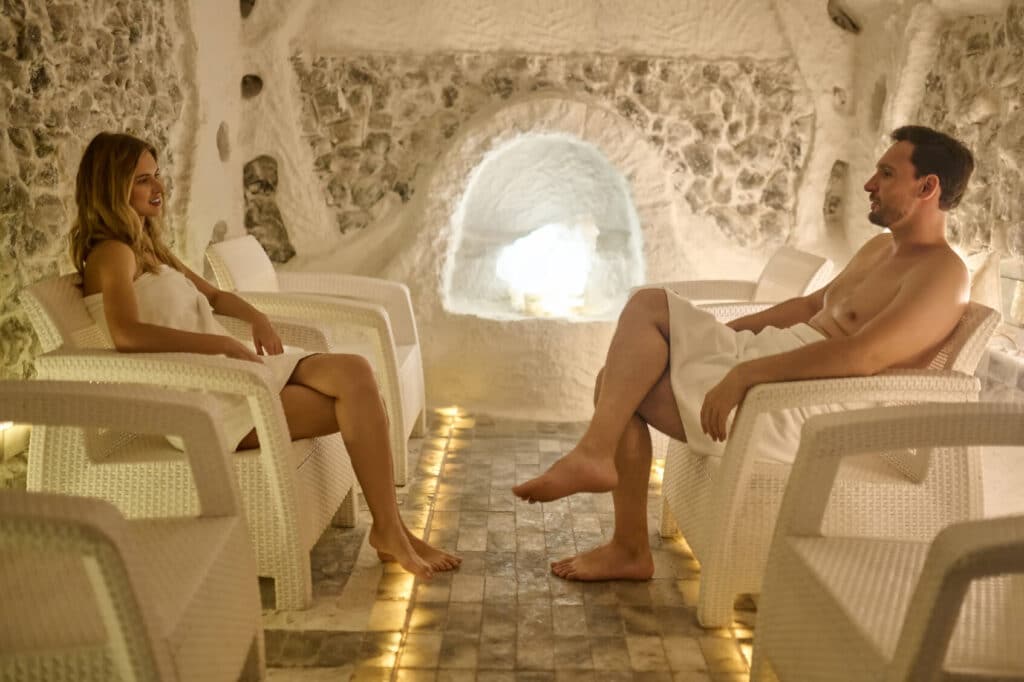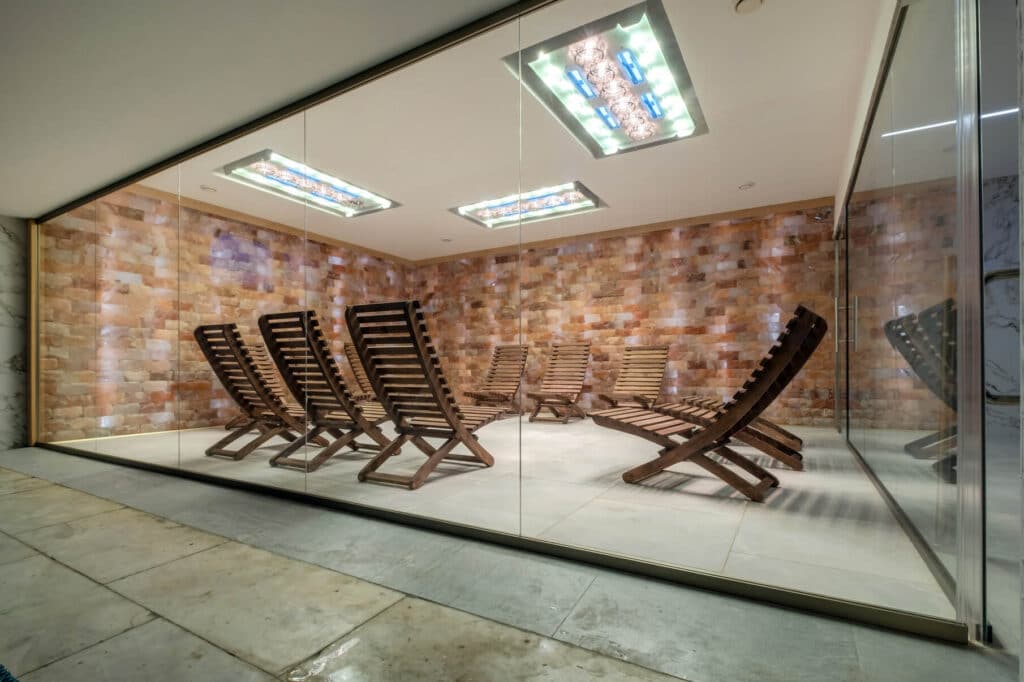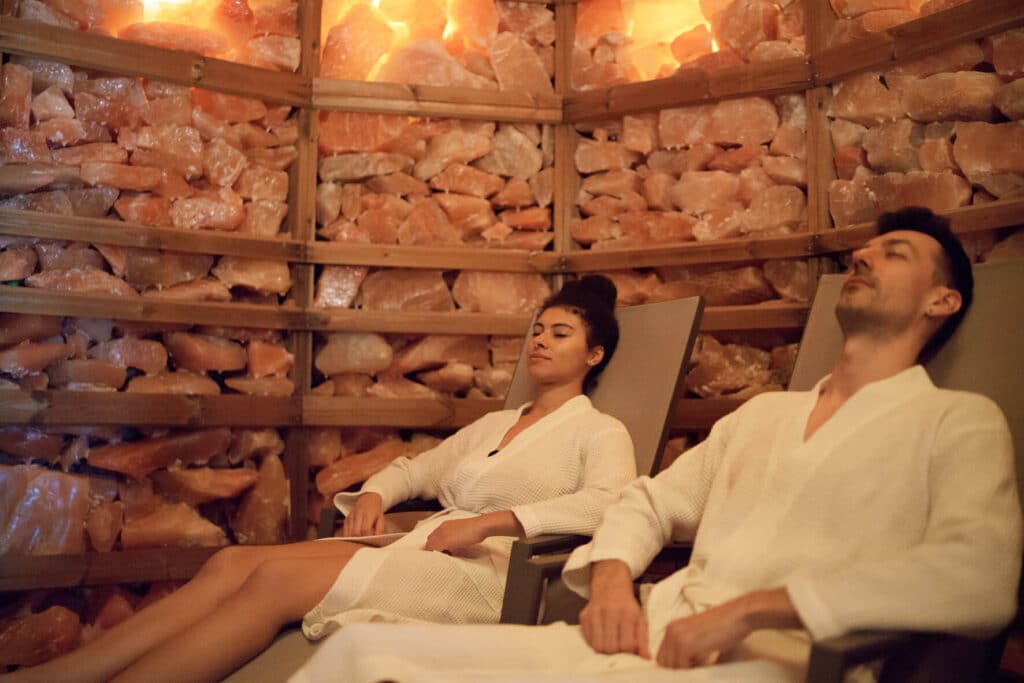In a world constantly in pursuit of holistic well-being, halotherapy has emerged as a go-to for those seeking a breath of fresh air — quite literally. But what exactly is halotherapy, and how does it work its magic on both respiratory and skin health? This guide contains everything you need to know about halotherapy: from what it is, to how it works, and how it benefits you.
Ready? Let’s dive in.

What Is Halotherapy?
Also known as salt therapy, halotherapy is a practice that involves inhaling dry salt particles in a closed space.
It originates from speleotherapy, which would see people spending extended periods of time in salt caves to address respiratory and skin conditions.
How Does Halotherapy Work?
Modern halotherapy normally takes place in a specially designed room or chamber, but you can also visit salt caves.
Here’s a brief breakdown of how it works:
1. Microclimate Simulation
The room or chamber’s temperature and humidity are changed to closely match the environment of natural salt caves, which are known for having therapeutic effects on the skin.
2. Dispersion
Once the environment has been recreated, finely ground salt particles are released into the air.
3. Inhalation
These finely ground particles are inhaled by the people in the room or chamber. The salt reaches different parts of the respiratory system, including the lungs and airways.
Treatment usually lasts from 30 to 60 minutes.
Types Of Salt Used In Halotherapy
In halotherapy, high-quality, pharmaceutical-grade salt is typically used.
It’s salt free from impurities, and specifically chosen for its therapeutic properties. The two main types of salt commonly used in halotherapy are:
Rock Salt:
- Rock salt is a naturally occurring salt extracted from salt mines. It is a type of mineral salt that is rich in various minerals, including sodium chloride.
- The salt is often crushed into fine particles to create the aerosol or dispersion used in halotherapy.\
Himalayan Salt:
- Sourced from the Himalayan mountain range, this is another type of salt used in halotherapy. It’s known for its iconic pink color, which comes from trace minerals present in the salt.
- Similar to rock salt, Himalayan salt is finely ground to create the fine particles used in halotherapy.

Does Halotherapy Work?
This one’s tricky to answer, because there hasn’t been an official consensus in the scientific community about the efficacy of halotherapy.
That being said, salt is known as a purifying substance, and the practice dates back hundreds of years.
Here are a few of the benefits some people have seen thanks to salt therapy:
- Mineral intake: The salt used in halotherapy is rich in minerals, and shows some therapeutic properties.
- Mucoactivity: Salt helps to clear mucus up from your airways
- Natural anti-inflammatory: It’s great for helping conditions like asthma and bronchitis
- Naturally antifungal & antibacterial: Because it’s also antibacterial and antifungal, it helps prevent infections.
But it’s also useful for your skin:
The tiny salt particles can help to repair your skin cells and prevent ageing and infection. It’s been used to treat acne, eczema, and psoriasis.
The Risks of Halotherapy
The main risks involved with halotherapy have to do with how it interacts with pre-existing conditions. If you’ve got high blood pressure, heart problems, and blood disorders like anemia, you should avoid halotherapy.
Types of Halotherapy
Halotherapy can be done in a number of ways.
Salt Caves
Salt caves are naturally occurring underground structures formed by the accumulation of salt deposits over millions of years. The air inside these caves is typically saturated with salt particles.
Halotherapy done in salt rooms or chambers can be broken down into active and passive.
Halotherapy Devices
Portable halotherapy devices for home use have become increasingly popular. These devices may include salt inhalers, salt lamps, or personal inhalers.
Salt Booths
Salt booths are enclosed spaces where individuals can sit or stand to inhale salt-infused air. Similar to salt rooms, these booths often use generators to distribute the salt particles evenly.
Salt Rooms
Dedicated salt rooms are designed with walls and sometimes floors made of salt, creating an environment infused with salt particles. Salt rooms often have specialized generators or machines that disperse fine salt aerosol into the air.
- Active: Active rooms have a machine called a halogenerator. Salt is added to it, and it breaks down that salt into tiny particles.
- Passive: Instead of a machine, these rooms are filled with different types of salt, and has a controlled temperature and humidity – like a salt cave.
The amount of salt in passive rooms is lower than active rooms, so it’s ideal for relaxation and meditation instead of more intensive halotherapy.

How To Find The Right Halotherapy Center
Choosing a reputable halotherapy place is crucial to ensure you make the most of your salt therapy experience. Here are some things to consider when selecting a halotherapy facility:
Reviews
Dive into reviews and testimonials from fellow visitors. Websites, social media platforms, or even wellness communities can give you insights into the center’s experience and what others have loved (or hated) about their halotherapy journey.
Qualifications
Having trained professionals on board ensures you’re in good hands for a safe and effective halotherapy adventure.
Salt Quality
You can’t use regular old table salt for halotherapy, and the halotherapy center shouldn’t either. Make sure that the center uses pharmaceutical-grade salt, so that your salt therapy experience is beneficial.
Types of Treatments
A standout halotherapy haven will spoil you with choices. Look for a place that offers a medley of halotherapy sessions. This way, you can pick and choose the perfect blend for your respiratory and skin wellness goals.
Cost
Consider the overall value, from diverse treatments to cozy amenities, and the general feel-good atmosphere of the halotherapy center.

How Air Doctor Can Help
Did you know if you need to find a doctor abroad you can use the Air Doctor app to find one – anywhere, anytime.
Air Doctor gives you:
- Access to over 20,000 multi-lingual doctors worldwide
- Choice of clinic, at-home (hotel), and video visits
- Local, valid prescriptions through our cross-border services
- Quality medical care, including urgent visits
- 24/7 multi-lingual customer support
- Video consultation services in up to 21 languages
- Partnered with leading insurance providers
Download the app, just in case.












